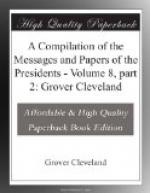That the translation which has hitherto been universally received as correct of the terms in the grant to Sir William Alexander is the true one, and that the new construction which is now attempted to be put upon it is inaccurate, will be shown in another place,[45] where will also be exhibited an error committed in rendering the sense of another part of that instrument. The consideration of the correctness or incorrectness of the several translations can form no part of the present argument. While, therefore, it is denied that Messrs. Mudge and Featherstonhaugh have succeeded in showing that the grant to Sir William Alexander has been mistranslated, it is maintained that an error in the translation of this document can have no effect in setting aside the simple and positive terms of the treaty of 1783. That treaty and its confirmation in the treaty of Ghent must be admitted to be null and void before that line can be drawn in any other direction than “due north.”
[Footnote 45: See Note V, pp. 143-147.]
III.—NORTH WEST ANGLE OF NOVA SCOTIA.
The term northwest angle of Nova Scotia was used in the secret instructions of Congress and is adopted in the treaty of 1783. In the instructions it is named without any explanation, as if it were a point perfectly well known. In one sense it was so, for although it never had been marked by a monument, nor perhaps visited by the foot of man, its position could be laid down upon a map; nay, was so on many existing maps, and the directions for finding it on the ground were clear and explicit. These directions are to be found in the royal proclamation of October, 1763, and in the commission to Montague Wilmot, governor of Nova Scotia, of cotemporaneous date. Any uncertainty in regard to the position of this angle which may have existed in relation to the meaning of the first of these instruments is removed by the act of Parliament of 1774, commonly called the Quebec act.
Before citing these instruments it will be proper to refer to the circumstances under which the two first were issued.




